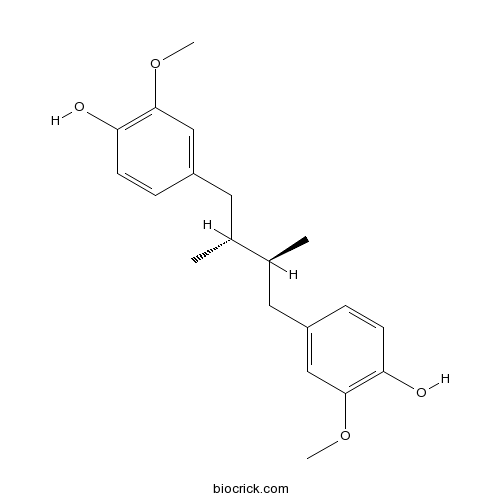Dihydroguaiaretic acidCAS# 66322-34-7 |

- (-)-Dihydroguaiaretic acid
Catalog No.:BCN8002
CAS No.:124649-78-1
Quality Control & MSDS
3D structure
Package In Stock
Number of papers citing our products

| Cas No. | 66322-34-7 | SDF | Download SDF |
| PubChem ID | 476856 | Appearance | Powder |
| Formula | C20H26O4 | M.Wt | 330.4 |
| Type of Compound | Lignans | Storage | Desiccate at -20°C |
| Solubility | Soluble in Chloroform,Dichloromethane,Ethyl Acetate,DMSO,Acetone,etc. | ||
| Chemical Name | 4-[(2S,3R)-4-(4-hydroxy-3-methoxyphenyl)-2,3-dimethylbutyl]-2-methoxyphenol | ||
| SMILES | CC(CC1=CC(=C(C=C1)O)OC)C(C)CC2=CC(=C(C=C2)O)OC | ||
| Standard InChIKey | ADFOLUXMYYCTRR-OKILXGFUSA-N | ||
| Standard InChI | InChI=1S/C20H26O4/c1-13(9-15-5-7-17(21)19(11-15)23-3)14(2)10-16-6-8-18(22)20(12-16)24-4/h5-8,11-14,21-22H,9-10H2,1-4H3/t13-,14+ | ||
| General tips | For obtaining a higher solubility , please warm the tube at 37 ℃ and shake it in the ultrasonic bath for a while.Stock solution can be stored below -20℃ for several months. We recommend that you prepare and use the solution on the same day. However, if the test schedule requires, the stock solutions can be prepared in advance, and the stock solution must be sealed and stored below -20℃. In general, the stock solution can be kept for several months. Before use, we recommend that you leave the vial at room temperature for at least an hour before opening it. |
||
| About Packaging | 1. The packaging of the product may be reversed during transportation, cause the high purity compounds to adhere to the neck or cap of the vial.Take the vail out of its packaging and shake gently until the compounds fall to the bottom of the vial. 2. For liquid products, please centrifuge at 500xg to gather the liquid to the bottom of the vial. 3. Try to avoid loss or contamination during the experiment. |
||
| Shipping Condition | Packaging according to customer requirements(5mg, 10mg, 20mg and more). Ship via FedEx, DHL, UPS, EMS or other couriers with RT, or blue ice upon request. | ||
| Description | 1. Dihydroguaiaretic acid has antioxidative activity, can significantly protect primary cultured neuronal cells against glutamate-induced oxidative stress. 2. Meso-dihydroguaiaretic acid inhibits the cyclooxygenase-2 (COX-2)-dependent phase of prostaglandin D2 (PGD2) generation in bone marrow-derived mast cells (BMMC) (IC50 9.8 μM). 3. Dihydroguaiaretic acid shows an inhibitory effect against the complex formation of the fos-jun dimer and the DNA consensus sequence with an IC50 value of 0.21 micromol, suppresses leukemia, lung cancer and colon cancer in an in vitro bioassay. |
| Targets | DNA/RNA Synthesis | COX |

Dihydroguaiaretic acid Dilution Calculator

Dihydroguaiaretic acid Molarity Calculator
| 1 mg | 5 mg | 10 mg | 20 mg | 25 mg | |
| 1 mM | 3.0266 mL | 15.1332 mL | 30.2663 mL | 60.5327 mL | 75.6659 mL |
| 5 mM | 0.6053 mL | 3.0266 mL | 6.0533 mL | 12.1065 mL | 15.1332 mL |
| 10 mM | 0.3027 mL | 1.5133 mL | 3.0266 mL | 6.0533 mL | 7.5666 mL |
| 50 mM | 0.0605 mL | 0.3027 mL | 0.6053 mL | 1.2107 mL | 1.5133 mL |
| 100 mM | 0.0303 mL | 0.1513 mL | 0.3027 mL | 0.6053 mL | 0.7567 mL |
| * Note: If you are in the process of experiment, it's necessary to make the dilution ratios of the samples. The dilution data above is only for reference. Normally, it's can get a better solubility within lower of Concentrations. | |||||

Calcutta University

University of Minnesota

University of Maryland School of Medicine

University of Illinois at Chicago

The Ohio State University

University of Zurich

Harvard University

Colorado State University

Auburn University

Yale University

Worcester Polytechnic Institute

Washington State University

Stanford University

University of Leipzig

Universidade da Beira Interior

The Institute of Cancer Research

Heidelberg University

University of Amsterdam

University of Auckland

TsingHua University

The University of Michigan

Miami University

DRURY University

Jilin University

Fudan University

Wuhan University

Sun Yat-sen University

Universite de Paris

Deemed University

Auckland University

The University of Tokyo

Korea University
- ML 171
Catalog No.:BCC6252
CAS No.:6631-94-3
- 3H-1,2-Benzodithiol-3-one-1,1-dioxide
Catalog No.:BCC8633
CAS No.:66304-01-6
- Pregomisin
Catalog No.:BCN7000
CAS No.:66280-26-0
- Gomisin J
Catalog No.:BCN2270
CAS No.:66280-25-9
- 4-Amino-2-methylquinoline
Catalog No.:BCC8677
CAS No.:6628-04-2
- 6'-O-Acetylpaniculoside II
Catalog No.:BCC8316
CAS No.:
- Stemonidine
Catalog No.:BCC8253
CAS No.:66267-46-7
- N-dotriacontanol
Catalog No.:BCC8218
CAS No.:6624-79-9
- N-Benzylanthranilic acid
Catalog No.:BCC9093
CAS No.:6622-55-5
- Cyromazine
Catalog No.:BCC5328
CAS No.:66215-27-8
- Deacetylxylopic acid
Catalog No.:BCN4210
CAS No.:6619-95-0
- Malic acid 4-Me ester
Catalog No.:BCN4209
CAS No.:66178-02-7
- 5'-Deoxy-5-fluorocytidine
Catalog No.:BCC8746
CAS No.:66335-38-4
- Ranitidine
Catalog No.:BCC9134
CAS No.:66357-35-5
- Ranitidine Hydrochloride
Catalog No.:BCC4533
CAS No.:66357-59-3
- TGX-221
Catalog No.:BCC1244
CAS No.:663619-89-4
- Methylsyringol
Catalog No.:BCN3535
CAS No.:6638-05-7
- (+)-Apogossypol
Catalog No.:BCC5585
CAS No.:66389-74-0
- Chloranthalactone A
Catalog No.:BCN8022
CAS No.:66395-02-6
- Chloranthalactone B
Catalog No.:BCN8020
CAS No.:66395-03-7
- 5alpha-Hydroxychloranthalactone A
Catalog No.:BCN7469
CAS No.:66395-04-8
- Pamoic acid disodium salt
Catalog No.:BCC7909
CAS No.:6640-22-8
- 13-Hydroxyoxyberberine
Catalog No.:BCN3355
CAS No.:66408-27-3
- 6-Amino-1,3-dimethyluracil
Catalog No.:BCC8755
CAS No.:6642-31-5
Acute larvicidal activity against mosquitoes and oxygen consumption inhibitory activity of dihydroguaiaretic acid derivatives.[Pubmed:25669766]
J Agric Food Chem. 2015 Mar 11;63(9):2442-8.
(-)-Dihydroguaiaretic acid (DGA) and its derivatives having 3-hydroxyphenyl (3-OH-DGA) and variously substituted phenyl groups instead of 3-hydroxy-4-methoxyphenyl groups were synthesized to measure their larvicidal activity against the mosquito Culex pipiens Linnaeus, 1758 (Diptera: Culicidae). Compared with DGA and 3-OH-DGA (LC50 (M), 3.52 x 10(-5) and 4.57 x 10(-5), respectively), (8R,8'R)-lignan-3-ol (3) and its 3-Me (10), 2-OH (12), 3-OH (13), and 2-OMe (15) derivatives showed low potency (ca. 6-8 x 10(-5) M). The 4-Me derivative (11) showed the lowest potency (12.1 x 10(-5) M), and the 2-F derivative (4) showed the highest (2.01 x 10(-5) M). All of the synthesized compounds induced an acute toxic symptom against mosquito larvae, with potency varying with the type and position of the substituents. The 4-F derivative (6), which killed larvae almost completely within 45 min, suppressed the O2 consumption of the mitochondrial fraction, demonstrating that this compound inhibited mitochondrial O2 consumption contributing to a respiratory inhibitory activity.


